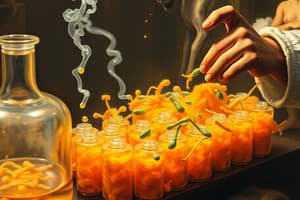Podcast
Questions and Answers
What is a pure culture?
What is a pure culture?
- A culture with a variety of microorganisms.
- A culture without any living organisms.
- A culture containing only one species or strain. (correct)
- A culture containing multiple species.
Which type of culture media is used to encourage the growth of desired microbes?
Which type of culture media is used to encourage the growth of desired microbes?
- Complex media
- Differential media
- Reducing media
- Selective media (correct)
What is the primary method used for isolating pure cultures?
What is the primary method used for isolating pure cultures?
- Streak plate method (correct)
- Spread plate method
- Dilution method
- Pour plate method
Which of the following describes binary fission?
Which of the following describes binary fission?
During which phase of growth are cells dividing at their most rapid rate?
During which phase of growth are cells dividing at their most rapid rate?
Microbial growth is best defined as an increase in what?
Microbial growth is best defined as an increase in what?
Which of the following is NOT a physical requirement for microbial growth?
Which of the following is NOT a physical requirement for microbial growth?
What is the optimum growth temperature range for mesophiles?
What is the optimum growth temperature range for mesophiles?
Which type of microorganism is most likely to cause food spoilage in a refrigerator?
Which type of microorganism is most likely to cause food spoilage in a refrigerator?
What pH range do most bacteria prefer for optimal growth?
What pH range do most bacteria prefer for optimal growth?
What is the name given to microbes that grow at very low pH?
What is the name given to microbes that grow at very low pH?
Which of the following describes the optimum growth temperature of hyperthermophiles?
Which of the following describes the optimum growth temperature of hyperthermophiles?
What happens to a cell in a hypertonic environment?
What happens to a cell in a hypertonic environment?
What is plasmolysis?
What is plasmolysis?
Which of the following is true of halophiles?
Which of the following is true of halophiles?
What is the role of carbon for bacteria?
What is the role of carbon for bacteria?
What is nitrogen used for in bacteria?
What is nitrogen used for in bacteria?
Which of the following uses CO2?
Which of the following uses CO2?
Why do obligate aerobes need oxygen?
Why do obligate aerobes need oxygen?
What is a characteristic of a facultative anaerobe?
What is a characteristic of a facultative anaerobe?
Which of the following is an example of an obligate aerobe?
Which of the following is an example of an obligate aerobe?
What conditions do capnophiles require to grow?
What conditions do capnophiles require to grow?
Which biosafety level requires the most stringent precautions?
Which biosafety level requires the most stringent precautions?
What is the purpose of selective media?
What is the purpose of selective media?
Saboraud’s Dextrose Agar is used to isolate what type of microbes?
Saboraud’s Dextrose Agar is used to isolate what type of microbes?
What is the main function of differential media?
What is the main function of differential media?
Which type of culture is primarily used to increase small numbers of a desired organism to detectable levels?
Which type of culture is primarily used to increase small numbers of a desired organism to detectable levels?
In a BSL-4 lab, how is exhaust air filtered?
In a BSL-4 lab, how is exhaust air filtered?
What basic precaution is required at a minimum in BSL-2 labs?
What basic precaution is required at a minimum in BSL-2 labs?
What is a common use for enrichment culture?
What is a common use for enrichment culture?
What is the pH of Saboraud’s Dextrose Agar?
What is the pH of Saboraud’s Dextrose Agar?
What is a chemically defined media?
What is a chemically defined media?
What is a characteristic of fastidious organisms?
What is a characteristic of fastidious organisms?
What is a complex media?
What is a complex media?
Which of the following is an example of a complex medium?
Which of the following is an example of a complex medium?
What is the purpose of using reducing media?
What is the purpose of using reducing media?
What chemical is used to reduce oxygen in anaerobic growth media?
What chemical is used to reduce oxygen in anaerobic growth media?
What is done to reducing media to remove oxygen?
What is done to reducing media to remove oxygen?
What type of organism is Escherichia coli?
What type of organism is Escherichia coli?
Which of the following is a component of nutrient agar?
Which of the following is a component of nutrient agar?
In what form is the agar added to nutrient agar?
In what form is the agar added to nutrient agar?
Flashcards
Microbial Growth
Microbial Growth
Increase in the number of cells, not cell size.
Physical Requirements for Growth
Physical Requirements for Growth
Factors that affect microbial growth include temperature, pH, and osmotic pressure.
Temperature Ranges
Temperature Ranges
Microbes thrive in specific temperature ranges: minimum, optimum, and maximum.
Psychrophiles
Psychrophiles
Signup and view all the flashcards
Acidophiles
Acidophiles
Signup and view all the flashcards
Neutrophiles
Neutrophiles
Signup and view all the flashcards
Alkaliphiles
Alkaliphiles
Signup and view all the flashcards
Osmotic Pressure
Osmotic Pressure
Signup and view all the flashcards
Hypertonic Environment
Hypertonic Environment
Signup and view all the flashcards
Plasmolysis
Plasmolysis
Signup and view all the flashcards
Hypotonic Environments
Hypotonic Environments
Signup and view all the flashcards
Halophiles
Halophiles
Signup and view all the flashcards
Obligate Halophiles
Obligate Halophiles
Signup and view all the flashcards
Facultative Halophiles
Facultative Halophiles
Signup and view all the flashcards
Nitrogen Fixation
Nitrogen Fixation
Signup and view all the flashcards
Obligate Aerobes
Obligate Aerobes
Signup and view all the flashcards
Chemically Defined Media
Chemically Defined Media
Signup and view all the flashcards
Selective Media
Selective Media
Signup and view all the flashcards
Streak Plate Method
Streak Plate Method
Signup and view all the flashcards
Generation Time
Generation Time
Signup and view all the flashcards
Phases of Bacterial Growth
Phases of Bacterial Growth
Signup and view all the flashcards
Fastidious organisms
Fastidious organisms
Signup and view all the flashcards
Complex media
Complex media
Signup and view all the flashcards
Nutrient broth
Nutrient broth
Signup and view all the flashcards
Nutrient agar
Nutrient agar
Signup and view all the flashcards
Reducing media
Reducing media
Signup and view all the flashcards
Sodium thioglycolate
Sodium thioglycolate
Signup and view all the flashcards
Anaerobic growth methods
Anaerobic growth methods
Signup and view all the flashcards
Anaerobic jar
Anaerobic jar
Signup and view all the flashcards
Anaerobic chamber
Anaerobic chamber
Signup and view all the flashcards
Capnophiles
Capnophiles
Signup and view all the flashcards
Biosafety Level 1 (BSL-1)
Biosafety Level 1 (BSL-1)
Signup and view all the flashcards
Biosafety Level 2 (BSL-2)
Biosafety Level 2 (BSL-2)
Signup and view all the flashcards
Biosafety Level 3 (BSL-3)
Biosafety Level 3 (BSL-3)
Signup and view all the flashcards
Biosafety Level 4 (BSL-4)
Biosafety Level 4 (BSL-4)
Signup and view all the flashcards
Differential Media
Differential Media
Signup and view all the flashcards
Enrichment Culture
Enrichment Culture
Signup and view all the flashcards
Saboraud’s Dextrose Agar
Saboraud’s Dextrose Agar
Signup and view all the flashcards
Selective and Differential Characteristics
Selective and Differential Characteristics
Signup and view all the flashcards
Study Notes
Microbial Growth
- Microbial growth is an increase in the number of cells, not cell size.
Requirements for Growth
-
Physical Requirements:
- Temperature:
- Minimum growth temperature
- Optimum growth temperature
- Maximum growth temperature
- pH: Most bacteria grow between pH 6.5 and 7.5; molds and yeasts grow between pH 5 and 6; acidophiles grow in acidic environments; acidity inhibits most microbial growth; alkalinity inhibits microbial growth but is not commonly used for food preservation.
- Osmotic pressure: Hypertonic environments (higher solute concentration in the surrounding environment than inside a cell) cause plasmolysis. Halophiles require moderate to large salt concentrations, obligate halophiles need high salt concentrations, and facultative halophiles tolerate salt.
- Temperature:
-
Chemical Requirements:
- Carbon: Structural backbone of organic molecules; chemoheterotrophs use organic molecules; autotrophs use CO2
- Nitrogen: Component of proteins, DNA, and ATP; most bacteria decompose protein materials for nitrogen; some use NH4+ or NO3–; others, use molecular nitrogen
- Sulfur: Used in amino acids, thiamine, and biotin; most bacteria decompose protein for the sulfur source; some use SO4 2- or H2S.
- Phosphorus: Used in DNA, RNA, and ATP; found in membranes; PO43– is a source of phosphorus.
- Oxygen:
- Obligate aerobes require oxygen to survive. A disadvantage is that oxygen isn't found in all environments and dissolves poorly in water
- Facultative anaerobes prefer oxygen but can survive without it
- Obligate anaerobes cannot use oxygen and are harmed by its presence
- Aerotolerant anaerobes cannot use oxygen but tolerate its presence
- Microaerophiles require oxygen, but at low concentrations, are sensitive to oxygen.
-
Trace Elements: Inorganic elements needed in small amounts, usually as enzyme cofactors, including iron, copper, molybdenum, and zinc.
-
Organic Growth Factors: Vitamins, amino acids, purines, and pyrimidines obtained from the environment.
Biofilms
- Microbial communities that grow in slime or hydrogel layers adhering to surfaces.
- Bacteria communicate via quorum sensing and share nutrients.
- Shelters bacteria from harmful environmental factors.
- Found in digestive systems, sewage treatment systems, and can clog pipes.
- Resistant to microbial control methods and are involved in 70% of infections.
Culture Media
- Culture media: Nutrients prepared for microbial growth.
- Sterile: No living microbes
- Inoculum: Introduction of microbes into a medium.
- Culture: Microbes growing in or on a culture medium.
- Agar: A solidifying agent in Petri plates, slants, and deeps that is often generally not metabolized by microbes. It liquefies at 100°C and solidifies around 40°C
- Chemically defined media: Exact chemical composition is known ; fastidious organisms require many growth factors
- Complex media: Extracts and digests of yeasts, meat, or plants; chemical composition varies.
- Nutrient broth: Liquid medium.
- Nutrient agar: Solid medium.
- Reducing media: Used for cultivating anaerobic bacteria; contains chemicals like sodium thioglycolate that deplete oxygen; heated to remove oxygen
- Anaerobic chamber: Used for cultivating anaerobic bacteria. This environment is fully enclosed and has conditions that eliminate oxygen (e.g. CO2).
Special Culture Techniques
- Capnophiles: Microbes requiring high CO2 conditions (CO2 packet, candle jar)
- Biosafety levels (BSL): Standards for lab safety in handling microbes (BSL-1 to BSL-4). BSL-4 labs are fully enclosed, and air is filtered prior to exhaust, are highly dangerous for the organisms housed and personnel.
Selective and Differential Media
- Selective media: Suppress unwanted microbes and encourage a specific microbe (e.g., Sabouraud's Dextrose Agar, pH of 5.6 prevents bacterial growth and used to isolate fungi).
- Differential media: Allow distinguishing colonies of different microbes on the same plate.
- Some media are both selective and differentiated.
Enrichment Culture
- Encourages the growth of a desired microbe, even in low numbers, to detectable levels.
- Unlike selective media, does not suppress the growth of other microbes.
- Often used for fecal and soil samples.
Obtaining Pure Cultures
- A pure culture has only one species or strain.
- A colony is a population of cells arising from a single cell (or spore) or a group of attached cells . A colony is often called a colony-forming unit (CFU).
- The streak plate method isolates pure cultures.
Preserving Bacterial Cultures
- Deep-freezing: -50° to -95°C
- Lyophilization (freeze-drying): Frozen (-54° to -72°C) and dehydrated in a vacuum.
Bacterial Division
- Increase in the number of cells, not cell size.
- Binary fission is the most common method.
- Budding, conidiospores (actinomycetes).
- Fragmentation of filaments.
Generation Time
- Time needed for a cell to divide.
- 20 minutes to 24 hours
- Binary fission doubles the number of cells each generation.
- Growth curves are represented logarithmically.
Phases of Growth
- Lag phase: Adjustment to new conditions; little or no cell division; intense metabolic activity.
- Log (or exponential) phase: Rapid growth—constant minimum division time. The number of cells produced is greater than the number dying.
- Stationary phase: Population stabilizes; number produced equals number dying. Factors that decrease growth include accumulation of toxic waste, acidic pH, limited nutrients, and limited oxygen.
- Death phase: Population decreases; number of cells dying is greater than the number of cells produced.Cells lose their ability to divide; although, some cells may remain alive for long periods
Direct Measurement of Microbial Growth
- Plate counts: Counting colonies (CFUs) on plates with 30-300 colonies. Serial dilutions are used to ensure the right number of colonies are counted. Pour plate method and spread plate method are used.
- Filtration: Solution passed through a filter, filter collected bacteria and transferred to the plate.
- Most probable number (MPN) method: Statistical estimation of bacteria in a sample.
- Direct microscopic count: Volume placed; average bacteria per viewing field; Petroff-Hausser cell counter.
Estimating Bacterial Numbers by Indirect Methods
- Turbidity: Measuring cloudiness of culture with a spectrophotometer
- Metabolic activity: Amount of metabolic products (e.g., glucose uptake) is proportional to the number of bacteria.
- Weight (dry weight): Bacteria filtered, dried, and weighed (used for filamentous organisms).
Studying That Suits You
Use AI to generate personalized quizzes and flashcards to suit your learning preferences.




